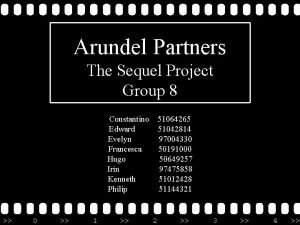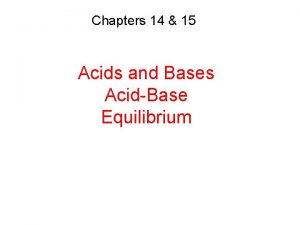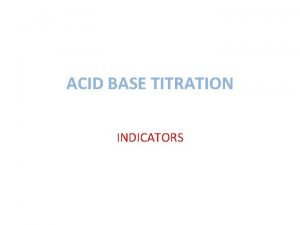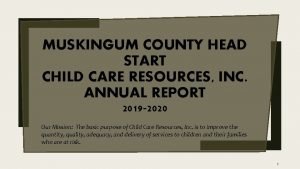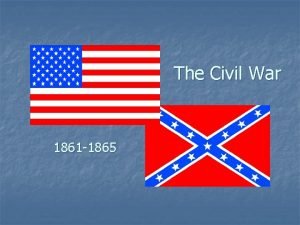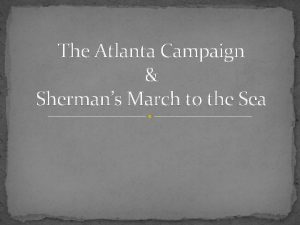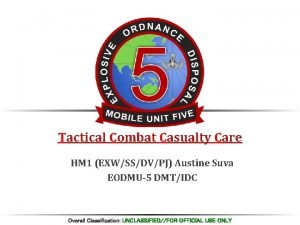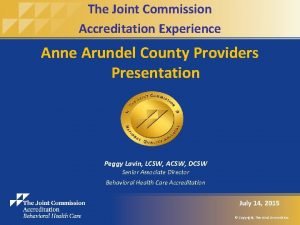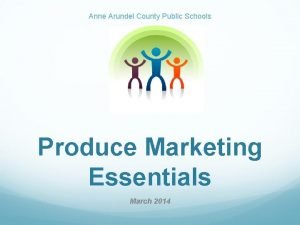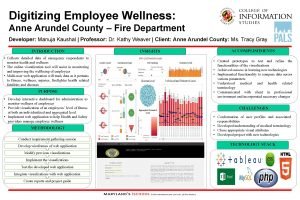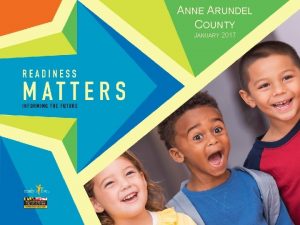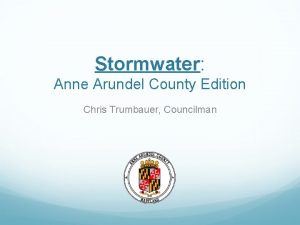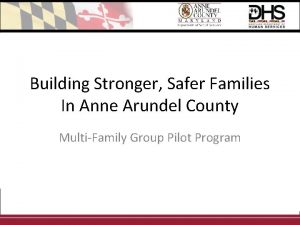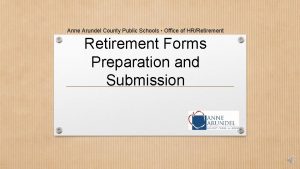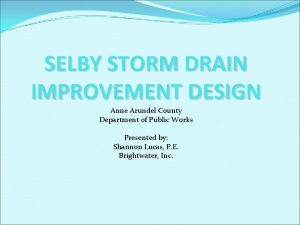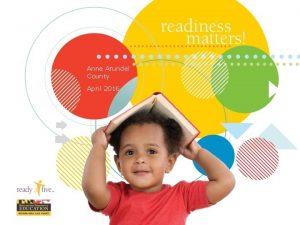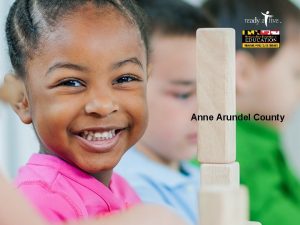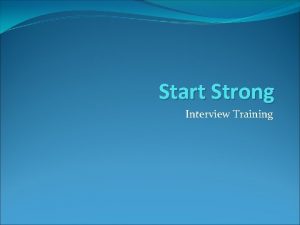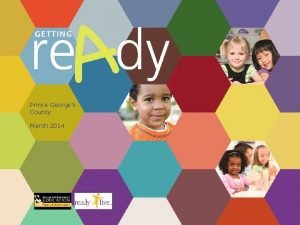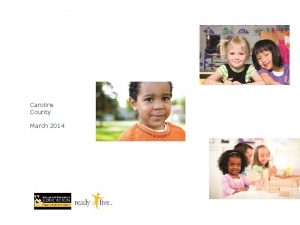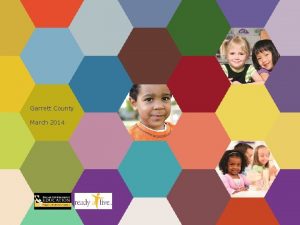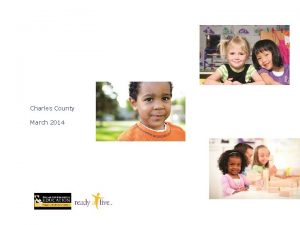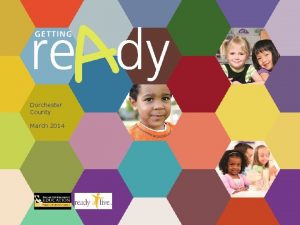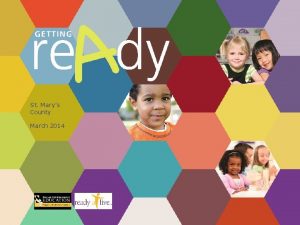Anne Arundel County March 2014 A Strong Start

























- Slides: 25

Anne Arundel County March 2014

A Strong Start for the Future School Readiness is Essential School Readiness • A child’s ability to successfully do kindergarten work. A Profound Effect • Children who enter school with high levels of readiness are more likely to succeed academically throughout their school careers, as well as later in life. • Research indicates that early experiences have a profound effect on the brain's development. • Children’s early years are the most important in shaping their formative growth and learning abilities.

How does Maryland Assess Readiness? Maryland Model for School Readiness (MMSR) An annual assessment on what each kindergartener knows and is able to do in the following areas or Domains of Learning: • Language & Literacy • Mathematical Thinking • Physical Development • Scientific Thinking • Social & Personal Development • Social Studies • The Arts

How does Maryland Assess Readiness? Maryland Model for School Readiness (MMSR) A kindergarten child is identified as: • Fully Ready Ø Consistently demonstrates the skills, behaviors, and abilities, which are needed to meet kindergarten expectations successfully. • Approaching Readiness Ø Inconsistently demonstrates the skills, behaviors, and abilities, which are needed to meet kindergarten expectations successfully and requires targeted instructional support in specific areas. • Developing Readiness Ø Does not demonstrate the skills, behaviors, and abilities, which are needed to meet kindergarten expectations and requires considerable instructional support in specific areas.

Statewide Highlights MMSR, 2013 -2014 Key Trends in Maryland • Continuing Our Strong Progress • • Achieving Higher Standards • • 83% of children entering kindergarten in school year 2013 -2014 are fully school-ready, up from 49% in 2001 -2002. This represents a 69% improvement in overall school readiness. The upward trend from school year 2001 -02 is evident for all subgroups of children. Working Diligently to Improve School Readiness • 96% of jurisdictions showed growth from 2001 -2002. • 12 jurisdictions reported higher levels of school readiness than 20122013. • 10 jurisdictions exceeded or are on par with the statewide school readiness average.

Statewide Highlights MMSR, 2013 -2014 Key Trends in Maryland • Sustaining Upward Trends Children receiving education services through an Individualized Education Program (IEP) exhibit overall higher school readiness. • • Narrowing Achievement Gaps • 77% of children from low-income households (as indicated by Free and Reduced Price Meal status) are fully school-ready in 2013 -2014. • • The 43 -point gain from 2001 -2002 reduced the readiness gap between children from low-income households and their mid-/high-income peers from 18 points to 11 points this year. 72% of English Language Learners (ELLs: children whose first language is not English) are fully school-ready in 2013 -2014, up from 35% in 2001 -2002. • The 3 -point rise in readiness from 2012 -2013 narrowed the disparity between ELLs and English-proficient children from 15 points to 13 points this year.

Statewide Highlights MMSR, 2013 -2014 Key Trends in Maryland • Ensuring a Sound Start • 39. 7% of kindergarten children previously attended public prekindergarten (Pre. K). • • 31% of Pre. K children participate in full day Pre. K programs. 14 jurisdictions currently offer a full-day option for some or all Pre. K children. • 83% of children who were enrolled in public Pre. K programs the year prior to starting kindergarten are fully school-ready, up from 47% in 20012002. • Children enrolled in public Pre. K programs the year prior to kindergarten: • Show greater long-term improvements (a 36 -point gain from 2001 -2002, compared with the 34 -point Statewide gain). • • Outperform their peers at the same income level. Are better prepared for school than children at home or in informal care.

Anne Arundel County Demographics of Young Children

Continuing Our Strong Progress MMSR, 2013 -2014 Full School Readiness Maryland Anne Arundel County 100 86 90 80 72 Percent 70 60 62 51 84 82 83 • 84% of Anne Arundel County’s kindergarten students are fully school-ready in 2013 -2014, a 33 -point readiness gain from 20012002. • The County’s kindergarteners outpace the statewide readiness level, currently at 83%. 68 58 50 40 81 86 49 30 20 10 0 01/02 04/05 Maryland 07/08 10/11 12/13 Anne Arundel County Source: Maryland State Department of Education 13/14

Continuing Our Strong Progress MMSR, 2013 -2014 Full School Readiness Anne Arundel County 100 90 80 • 84% of Anne Arundel County’s kindergarteners are fully ready for school in 2013 -2014, up from 51% in 2001 -2002. • The County exhibits an overall upward trend – a 65% improvement in school readiness since 2001 -2002. • 2% of kindergarteners (157 children) require considerable support to do kindergarten work. 84 72 70 Percent 86 86 62 60 50 51 40 44 33 25 30 20 13 12 10 13 5 4 3 1 2 2 01/02 04/05 07/08 10/11 12/13 13/14 0 Full Approaching Developing Trendline Note: A “Trendline” denotes the overall upward progression of the County’s full school readiness levels. Source: Maryland State Department of Education

Achieving Higher Standards MMSR, 2013 -2014 Anne Arundel County Full School Readiness by Domain • 71 Language & Literacy 40 77 Mathematical Thinking 42 In key Domains of Learning, kindergarteners experienced longterm gains: • Language & Literacy: 71% fully ready for 2013 -2014 (a 31 -point increase from 20012002) • Mathematical Thinking: 77% fully ready (a 35 -point jump) • Scientific Thinking: 75% fully ready (a 53 -point gain) • Social & Personal: 78% fully ready (an 18 -point improvement) 89 Physical Development 60 75 Scientific Thinking 22 Social & Personal Development 78 60 81 Social Studies 36 84 The Arts 48 0 20 40 13/14 Percent 12/13 60 01/02 Source: Maryland State Department of Education 80 100

Sustaining Upward Trends MMSR, 2013 -2014 Anne Arundel County Full School Readiness by Ethnicity 80 African American • 76% of Hispanic children are fully school-ready, a 39 -point gain from 2001 -2002. • African-American and Hispanic children exhibit substantially higher long-term readiness gains than their Anne Arundel County peers (a 33 -point increase). 76 40 90 Asian 47 76 Hispanic Two or More Races 80% of African-American children are fully school-ready in 2013 -2014, a 40 -point gain from 2001 -2002. 40 American Indian Native Hawaiian/Pacific Islander • 37 73 86 87 White 54 0 20 40 60 Percent 13/14 12/13 01/02 - Not Tracked Source: Maryland State Department of Education 80 100

Sustaining Upward Trends MMSR, 2013 -2014 Anne Arundel County Full School Readiness by Gender • 87% of females are fully schoolready in 2013 -2014, up from 58% in 2001 -2002. • 81% of males are fully ready, a 37 -point gain from 2001 -2002. • These gains reduced the readiness gap between males and females from 14 to 6 points. 84 All 51 87 Female 58 81 Male 44 0 20 40 Percent 13/14 60 12/13 80 01/02 Source: Maryland State Department of Education 100

Sustaining Upward Trends MMSR, 2013 -2014 Anne Arundel County Full School Readiness by Disability Status 100 89 88 • 53% of children receiving special education services through an Individualized Education Program (IEP) are fully school-ready in 20132014, a 10 -point gain from 2001 -2002. • The readiness gap between children with disabilities and their peers rose from 8 points in 2001 -2002 to 34 points this year. • 7. 7% of kindergarteners (494 children) have a disability – a 7% increase in the past year. 87 74 80 Percent 64 60 40 51 43 59 37 58 53 41 20 0 01/02 04/05 07/08 Children with Disabilities 10/11 12/13 13/14 Children w/o Disabilities Source: Maryland State Department of Education

Narrowing the Readiness Gap MMSR, 2013 -2014 Anne Arundel County Full School Readiness by Income Status 100 65 Percent 76% of children from low-income households (as indicated by Free and Reduced Price Meal status) are fully school-ready in 2013 -2014. • The 40 -point gain from 2001 -2002 reduced the readiness gap between children from low-income households and their mid-/highincome peers from 16 points to 13 points this year. • 35. 5% of kindergarteners (2, 268 children) in 2013 -2014 are from low-income households – a 106% one-year increase. 89 88 87 76 78 76 10/11 12/13 13/14 77 80 60 • 52 50 40 55 36 20 0 01/02 04/05 07/08 Children from Low-Income Households Children from Mid- to High-Income Households Source: Maryland State Department of Education

Narrowing the Readiness Gap MMSR, 2013 -2014 Anne Arundel County Full School Readiness by English Proficiency 100 88 80 Percent 68 51 40 20 85 72 72 72% of English Language Learners (ELLs: children whose first language is not English) are fully school-ready in 2013 -2014, up from 32% in 2001 -2002. • The 40 -point rise in readiness from 2001 -2002 closed the disparity between ELLs and Englishproficient children from 19 points to 13 points this year. • 9. 5% of kindergarteners are ELLs (606 children); this is a 5% oneyear increase. 73 63 60 87 • 40 47 32 0 01/02 04/05 07/08 English Language Learners 10/11 12/13 13/14 English Proficient Source: Maryland State Department of Education

Examining the Readiness Gap MMSR, 2013 -2014 Anne Arundel County Skills Gap Status Full Readiness in Language & Literacy by Subgroups 40 35 30 25 32 32 25 27 35 37 38 • In Language & Literacy, the readiness gap between ELLs and their English-proficient peers fell 7 points from 2010 -2011 (currently a 25 -point gap exists). • ELLs who enter school approximately two years below their English proficient peers in the area of Language & Literacy are not able to “catch up” by eighth grade. 1 25 19 20 19 14 13 15 10 5 0 English Language Learners 10/11 Gap Low Income 11/12 Gap Children with Disabilities 12/13 Gap 13/14 Gap Mancilla-Martinez, J. , & Lesaux, N. K. (2010). Predictors of Reading Comprehension for Struggling Readers: The Case of Spanish-Speaking Language Minority Learners. Journal of Educational Psychology, 102(3), 701 -711. 1 Source: Maryland State Department of Education

Ensuring A Sound Start Predominate Care Prior to Kindergarten Anne Arundel County Prior Care Enrollment of Kindergarteners • 21, 0% 15, 3% 12, 7% 2, 9% 21, 7% 25, 8% Child Care Center Family Child Care Head Start Home/Informal Care Non-public Nursery Pre. K 21. 0% of the County’s children who are currently enrolled in kindergarten attended a public prekindergarten (Pre. K) program in 2012 -2013. In 2013 -2014: • 1, 993 children (4 - and 5 -yearolds) attend a public Pre. K program. • 34% of Pre. K children participate in full-day programs. Repeat K NOTE: Prior Care Enrollment denotes the early care & education setting of children the year prior to kindergarten (i. e. school year 2012 -2013). Some prior care settings have enrollment criteria. For example, Head Start and public Pre. K almost exclusively serve children from low-income households and children with disabilities—two subgroups that have consistently had significantly lower school readiness than Maryland kindergarteners, as a whole, and are considered at risk. Source: Maryland State Department of Education

Ensuring A Sound Start MMSR, 2013 -2014 Anne Arundel County Full School Readiness by Prior Care Settings 90 Child Care Center • 81% of children who were enrolled in public Pre. K programs prior to starting kindergarten are fully school-ready, up from 48% in 2001 -2002. • Children attending public Pre. K programs (81% fully ready) are better prepared for school than their peers who were at home or received informal care (79%). 46 81 Family Child Care 54 81 Head Start 30 79 Home/Informal Care 36 92 Non-public Nursery 67 81 Pre. K 48 0 20 13/14 40 12/13 60 01/02 Source: Maryland State Department of Education 80 100

Ensuring A Sound Start MMSR, 2013 -2014 Anne Arundel County Full School Readiness by Pre. K • 84 All 51 76 Low-Income 36 81 Pre. K 48 0 20 13/14 40 12/13 60 01/02 Source: Maryland State Department of Education 80 100 Children attending public Pre. K programs – the majority of whom are from low-income households – outperform their peers at the same income level (81% of children with Pre. K experience are fully ready compared with 76% of kindergarteners from low-income households).

Strategic Investments Building A Firm Foundation Maryland is committed to creating a world-class education system that prepares students for college and career success in the 21 st century. Early education is an integral part of this vision. Maryland’s Substantial Investments • Maryland Model for School Readiness • Full-Day Kindergarten • Pre. K for Children with Significant Risk Factors • A Strong Governance Infrastructure • An Expanded Early Learning Framework • An Interactive Guide to Early Childhood Pedagogy • A Strengthened Early Care & Education Workforce • Engaged Families & Communities

A New System for Assessing School Readiness Measuring Early Learning for the 21 st Century Ready for Kindergarten (R 4 K): Maryland’s Early Childhood Comprehensive Assessment System • Builds on the success of the MMSR. • Aligns with the more rigorous Maryland College and Career-Ready Standards for K-12 instruction. • Enhances the birth-to-Grade 12 learning continuum. • Is supported by extensive professional development for teachers and child care professionals, as well as school and system administrators. • Monitors children’s learning progress and gauges the school readiness of incoming kindergarteners through computer-based assessment. • Connects to the state longitudinal data systems to allow for consistent and meaningful reporting at the student, class, school, district, and state levels.

A New System for Assessing School Readiness Measuring Early Learning for the 21 st Century Domains of Child Learning R 4 K measures a child’s learning progression (knowledge, skills, and abilities) in seven domains. These domains were adapted from the Domains of Learning currently used in the MMSR. They are: • Social Foundations • Physical Well-Being and Motor Development • Language and Literacy • Mathematics • Science • Social Studies • The Arts

A New System for Assessing School Readiness Measuring Early Learning for the 21 st Century R 4 K has two components: • An Early Learning Assessment measures the progress of learning in young children, 36 to 72 months (3 to 6 years old). • Each child’s progress is monitored along a continuum and tracked over time. • Early educators can create individualized learning opportunities and plan interventions, if needed, to ensure that children are on the path of kindergarten readiness. • Kindergarten Readiness Assessment (KRA) is administered to all incoming kindergarteners, measuring school readiness in seven developmental domains. • Snapshot of school readiness, making it possible to determine if entering students have the knowledge, skills, and abilities required to succeed in kindergarten. • The KRA also identifies the individual needs of children, enabling teachers to make informed instructional decisions.

A New System for Assessing School Readiness Measuring Early Learning for the 21 st Century Implementing R 4 K • Statewide Technology Infrastructure • All R 4 K data is entered into an online reporting system—a dashboard that integrates results to produce reports for teachers, school administrators, and families. • The system will also produce reports for children with disabilities that align with Maryland’s online Individualized Education Plan (IEP) system. • Professional Development Program • Support for teachers and administrators in the effective use of R 4 K. • State-approved trainers will provide R 4 K professional development to all kindergarten teachers throughout Maryland (in spring and summer of 2014). • School systems will begin implementing the new system in school year 2014 -2015. • The Early Learning Assessment for younger children will be launched in late winter 2015; it is optional for programs.
 Anne arundel county fire stations list
Anne arundel county fire stations list Anne arundel crisis response
Anne arundel crisis response Ephesians 6:10-20 nkjv
Ephesians 6:10-20 nkjv Anthem of poland
Anthem of poland Mr bleaney genius
Mr bleaney genius Arundel partners the sequel project case solution
Arundel partners the sequel project case solution Arundel zamek
Arundel zamek Strong base weak base
Strong base weak base Strong acid weak base titration graph
Strong acid weak base titration graph How to remember strong acids and strong bases
How to remember strong acids and strong bases Reading a titration curve
Reading a titration curve Strong base
Strong base Neutralization equation
Neutralization equation But we gotta start somewhere
But we gotta start somewhere Start/jump start triage algorithm
Start/jump start triage algorithm Muskingum county head start
Muskingum county head start Grihalakshmi magazine march 2019
Grihalakshmi magazine march 2019 Vincent van gogh born
Vincent van gogh born Genetic engineering conclusion
Genetic engineering conclusion March 1917 revolution
March 1917 revolution Sherman's march to sea map
Sherman's march to sea map Sherman's march significance
Sherman's march significance Path of sherman's march to the sea
Path of sherman's march to the sea Path of sherman's march to the sea
Path of sherman's march to the sea 9 line medevac
9 line medevac Che guevara aleida march de la torre
Che guevara aleida march de la torre





